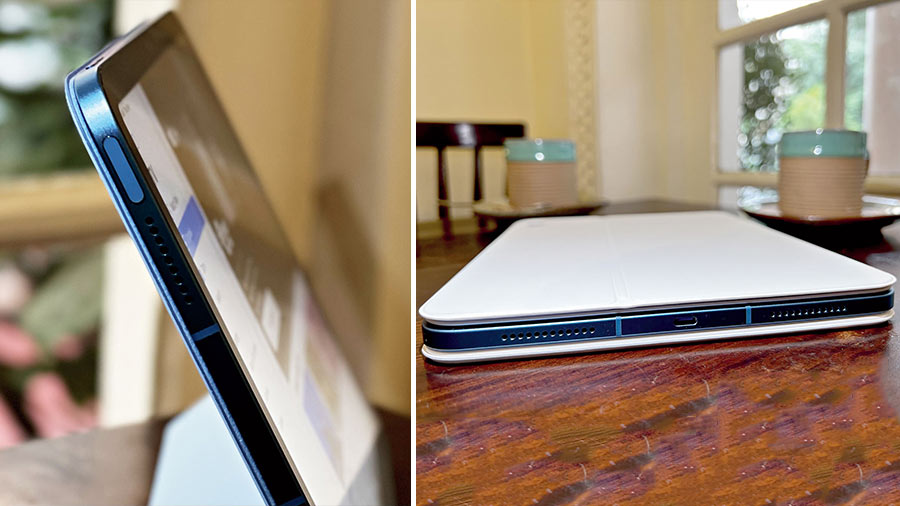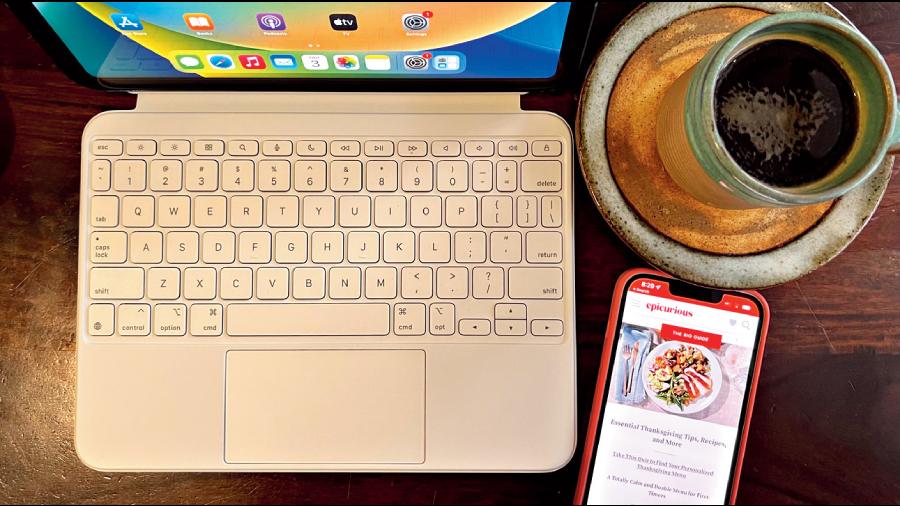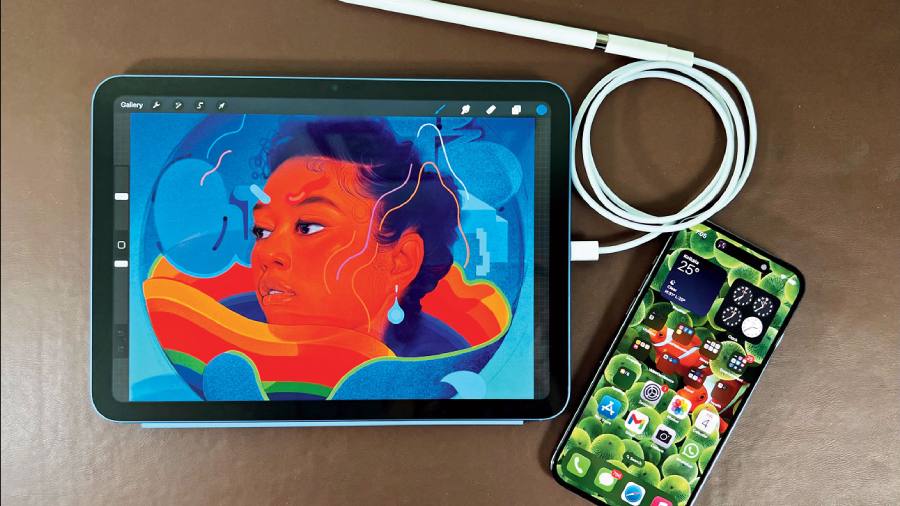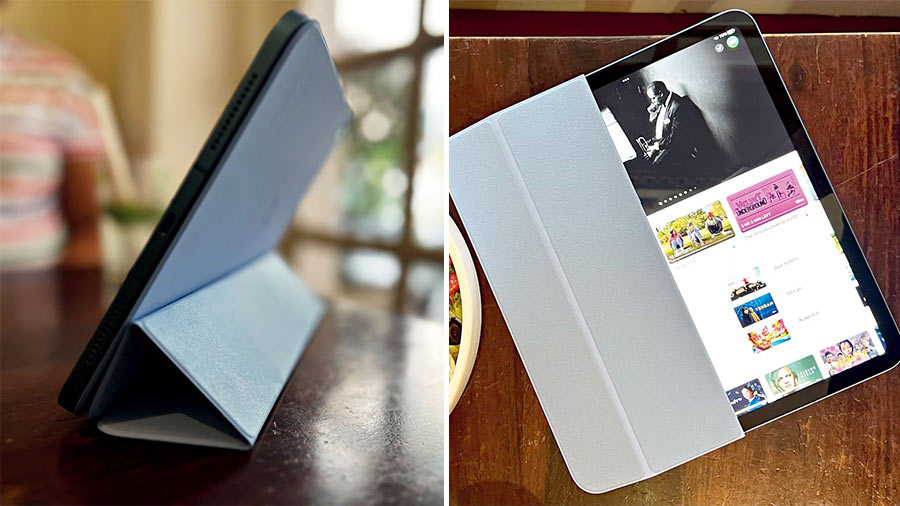Yesterday’s bread is solid gold when it comes to making French toast, gazpacho, croutons, bread puddings and what not. You really don’t need to upgrade a recipe for the sake of an upgrade. Apple has a strangely efficient habit of not touching some of its products for years, allowing it to mature, before giving it a complete makeover, turning it into something fresh. For some brands, constant design upgrades are akin to checkmarks on a spec list while for Apple, it’s a serious affair. Last year, the iMac was given a fresh wardrobe and this year, it’s the turn of the basic iPad, the one students use a lot, the one that has had the same design for years. It’s time to grow up.
Those with a job to follow technology closely may see many familiar things in the tenth-generation iPad but that’s not the case for people who are using the product the first time. To them it’s like taking out a new fun device out of the box, hoping it will serve for years to come. The entry-level iPad often becomes the first step into the Apple universe, besides being the device of choice for zillions of educational institutions across the globe.
Just in time for FIFA World Cup
With the Home button giving way to Touch ID, the design language is now closer to the entire family of iPads, making room for even-sized bezels all around. At the same time, the processor — A14 Bionic that was in 2020’s iPhone 12 — is capable of tackling every task thrown at it. There is more than enough power for most of the things students will use the iPad for. Beyond students, this iPad can also be a great content-consumption device.
It’s essential to remember what each iPad can do. An architect may spend the better half of the day with 3D modelling, which the iPad Pro can handle smoothly. The same goes for video editing as well as resource-hungry gaming. The iPad Air suits office-goers, who are constantly travelling and want a light device that’s powerful for office-y stuff. The iPad Mini is a favourite among pilots, gamers as well as the bibliophile. The simple iPad is a student’s lifeline, thanks to its note-taking capabilities, for being a library on the move as well as FaceTime-ing. At the same time, students can start with the iPad and work their way up the iPad ladder. The tenth-generation iPad is no slouch because it can tackle Zoom, Slack, Procreate, Adobe Fresco, Notability and similar apps. At the same time, the 10.9-inch screen is more immersive than before, which will help watch the World Cup later this month. This is basically a cheaper iPad Air with interesting updates.

The entry-level iPad has traded in the Home button for Touch ID and Lightning port has given way to USB-C charging port (right)
For someone who is using the latest iPad Pro and iPhone 14 Pro Max, here is something that struck me interesting — speed. I know the A14 Bionic chip is not as fast as the M1 or M2 processors or even the A16 Bionic chip powering the new Pro Max, yet the amount of speed the new iPad offers is mindboggling. Maybe I won’t render long 4K videos on the new offering but I can still run multiple apps side by side, keep a thousand apps running in the background and play graphic-heavy games seamlessly, without glitches. That’s the power of the Apple silicon.
Among the big updates is the placement of the front camera, which is now in the middle of the longer right bezel. Apple is late cottoning on to the change but then, it’s never too late to make a practical move. With the change in the placement of the camera, one can now look straight at the iPad and not sideways, showing off double/triple chin. Combined with Centre Stage, this is a fine technology to have.
Since we are on the topic of camera, the rear snapper is now improved, offering 12MP output while 4K video recording is possible. This is an excellent feature because students are often not allowed to use phones in schools and colleges but they need to take pictures of notes as well as those for projects. The camera system rocks.
The second update one needs to be aware of is the change in the charging port. This year onwards, it’s USB-C charging, which means one more device that does away with the Lightning port. USB-C ports have been appearing on several Apple devices over the years and if the iPhone decides to go with it from next year, it will be one cable for all devices.
Now that the basic iPad has the same design DNA as the Air and Pro, one area Apple decided to hold back on is the display type as students want repairs to be inexpensive. This is a very high quality Liquid Retina display with IPS technology. On the iPad Air and Pro, the screen is laminated, which means there is no gap between the glass and display. Here, it is not laminated and that keeps cost down. To the naked eye, nobody will ever notice. If the user drops the iPad and the screen cracks, chances are that the top glass will suffer and not the display as such, making it easy to repair.

The Magic Keyboard Folio comes with a row of function keys
Allow the fingers to do some magic
The most fascinating part of the new iPad comes in the form of an accessory you need to buy separately. Called Magic Keyboard Folio, it takes inspiration from Apple’s own Magic Keyboard. As the name suggests, it’s a folio-style keyboard that has two pieces. One part magnetically attaches to the back and comes with a kickstand, so the iPad can be propped up anywhere, helping with video calls or watching films. The second part attaches magnetically to the iPad and works as a keyboard. The typing experience is as good as on the Magic Keyboard, offering excellent key travel and spacing. There is a sizeable trackpad that hasn’t failed thus far. And to the envious part — there is a full row of function keys to handle media controls, brightness and even a lock button; it’s something we don’t get on the more expensive Magic Keyboard.
Why do you need a keyboard? A missive to send. An email to respond to. Keying in long notes. There are enough use case scenarios. Once used, it will be difficult to think of the pre-Magic Keyboard Folio era. It will take a couple of generations for the accessory to become an integral part of the experience. Of course, there are third-party options if cost becomes a worrying factor on the final bill.

The new iPad is compatible with Apple Pencil (first generation)
As much as I love the new keyboard, contradictions pave the way the Apple Pencil now functions. The iPad supports the first generation of Apple Pencil, which is absolutely fine in itself and I can live with the Lightning port on one end of the note-taking device. Previous generation iPads came with Lightning port, so you could charge the Pencil by plugging it into the port. What you now get is the same Pencil but the iPad has USB-C port. As part of the package, there is an adapter to help you charge the Pencil, which is thoughtful but it’s that one extra step to charge the device. From Apple’s perspective, there is a sizeable pool of Pencil in the market that can still be used. What I would have liked to see is support for both generations of Apple Pencil. Until that happens, I would rather charge the Pencil by sticking it into the iPhone port.
So, does the Pencil function well? Drawing and note-taking experience remains top-notch, the best you will see on any tablet.

The ninth-gen iPad (left) and the new tenth-gen iPad
Who is it for?
The tenth-generation iPad is still for students, who like to have something compact to take down notes and watch videos on. The same old Apple magic of fast performance meets excellent battery life and a vast library of apps greets the user as does a large, bright touchscreen. There is even a strong braided USB-C cable in the box alongside a 20W charging brick. I can even overlook the fact that the 3.5mm headphone jack has gone missing because the ninth-gen iPad is still available at a cheaper price.
Teenagers can get some of the top features that have come with iPadOS 16, like editable messages and collaboration features. There is no access to Stage Manager and the target users don’t need it. In case you are new to the iPad, this is the machine instead of the ninth-gen model. If you are using the ninth-gen model, chances are you will stick with it. For anyone using older generations iPads, the new device is a good upgrade. As for pricing, tags on all devices (irrespective of brand) are getting hefty. The colours add to the charm — blue, pink, yellow (and silver), reminding students of the highlighters they use.
It was time for the basic iPad to get promoted to the next class. That has happened and the iPad is a teenager, still running at full speed.

There is also the option of using a simple folio cover that can also be used to prop up the device
At a glance
Device: iPad (tenth-gen, 2022)
Price: Upwards of Rs 44,900 (Magic Keyboard Folio needs to be bought separately)
High notes
Larger screen
USB-C charging
Very fast A14 Bionic chip
Excellent battery life
Plenty of tablet-optimised apps available
Front-facing camera is on the long right bezel
Magic Keyboard Folio is a helpful accessory
Muffled notes
Apple Pencil second gen support would have helped
Base model could have had 128GB storage
